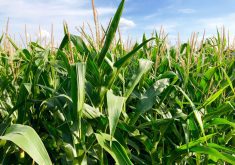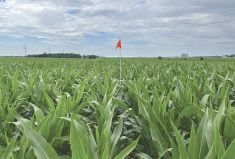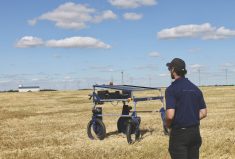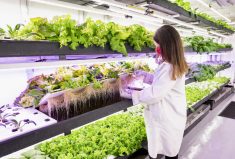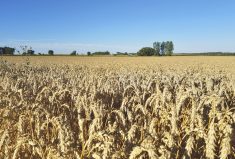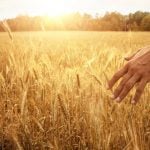The colours of agriculture are changing. Today a trade show is a patchwork — three shades of green, several types of red, the standard blue and even some yellow.
But farmers aren’t just looking at the colour of the paint when they shop for tractors and implements these days. According to Henry Holtmann, vice-chair of Dairy Farmers of Manitoba, rising input costs mean farmers are trying to be more efficient. “When a bag of corn seed costs $200 and it only seeds around two acres, you want to be as precise as possible,” Holtmann says.
Read Also

Could crop sharing be a viable option for your farm?
Crop sharing could be a good option for young and beginning farmers.
So farmers like Holtmann are turning to precision agriculture, an interactive computer-generated data collection and management system that allows them to analyze and adjust to almost every aspect of their operation.
Holtmann uses precision agriculture in his dairy and for his field crops. There are 1,000 cows, heifers and calves on Holtmann’s 2,700-acre family dairy farm, Rosser Holsteins, where they grow corn, alfalfa, barley, and oats for feed. They grow cash crops including soybeans and canola, on the land not used for feed production.
Holtmann says he’s been using precision agriculture in the dairy barn for years, measuring feed and tracking production levels and quality of milk. He uses it to monitor the activity of each animal and what and how much feed it’s receiving. Accuracy is the keyword. With “real time feeding and measuring of the feeds” Holtmann is able to adjust rations from a remote computer using WiFi to ensure the cows are getting what they need. He can even check if the milking activities are following protocol and problem solve using this “bird’s-eye view.”
A recent event at the dairy has Holtmann considering a new purchase. An early season snowfall caused a drop in milk production just days later. Holtmann says a hand-held infrared sensor would have saved almost $1,200 in production loss because the feed weights were skewed by the moisture content from the snow, which meant the cows weren’t getting enough feed.
If he’d had the technology, he could have adjusted the rations immediately without losing production, and the cows would have been a lot happier too.

Holtmann also invested in precision agriculture systems to grow his crops. He says a farmer has to choose a system carefully. The wrong choice can be costly.
Choosing the right data collection system for a farm operation is as critical to the success of the farm as buying the right tractor and implements, he says.
Systems range from just under $1,000 for a basic GPS designed to guide a tractor along the field rows to eliminate overlapping distribution of seed or fertilizer right on up to $20,000 or more, according to Tammy Epple, sales marketing manager for Outback Guidance. She says the more expensive the system the more information it will provide.
Epple says precision agriculture has quickly evolved from a basic GPS satellite guidance system in a tractor that was initially designed to prevent overlapping. Now the systems have sophisticated software that tracks yields and provides detailed application maps for every field on the farm, even telling the sprayer when to spray and how much to spray on a particular part of a field.
“It’s all about return on investment for the farmer,” Epple says. She says her company focuses on being able to provide software that’s compatible with all equipment, no matter what colour it is.
Holtmann agrees that it’s a far cry from straight GPS. Farmers want an information system that will “talk” or interface with equipment from a variety of manufacturers rather than a system that will only talk to one line of equipment. He says the first purchase is critical. Once a farmer purchases a system they’re tied to it unless they’re willing to take a loss and purchase a new one later. Accessing more advanced systems in the future can be costly.
According to Holtmann, there are several things a farmer needs to consider when buying a precision agriculture knowledge system. First is compatibility. He says if the system is ISO compatible, then a farmer is more interested in it and willing to pay more because it has the ability to talk to different manufacturers’ implements and adapt to new software. In addition, the system must allow the farmer to change instructions on the go in the field and then record that data.
Holtmann adds that although GPS-based systems can ensure there’s no row overlap for either seeding, fertilizing or spraying, any new system should also ensure every seed is placed correctly for maximum development and yield. The system should also allow the farmer to adjust seed placement right from the cab, whether it’s seed or row spacing, it’s important to be able to control it.
“If you start measuring the number of seeds per acre and the amount of yield you get back, then you can start doing the analysis for precision agriculture… then you can make some decisions,” Holtmann says.
Holtmann is using precision agriculture software with corn now but, in his estimation, the technology isn’t ready for soybeans. When his comparisons indicate there’s a benefit to investing in the equipment and the software for that crop, he says he’ll buy it.
“Over the next 10 years our priority is changing [our] equipment and information technology to better use the resources we have,” Holtmann says. It’s not about trading in a 30-foot seeder for a 60-foot seeder, he says. It’s about getting more precise in that 30 feet.
The main consideration for new investments for precision agriculture at Rosser Holsteins is the ability of the equipment to adapt to changing needs. Holtmann says they’ll consider how the equipment talks to the information system they’ve tied themselves to and they’ll be looking for guidance on the actual information technologies or variable rate technologies as they become available.
“That’s where we’re going,” Holtmann says. “Those are the things that interest us and that’s how we’ll make those decisions.” They’re willing to spend the money to invest in an information system that will provide additional information as time goes on, he adds.
But equipment and software designed for precision agriculture is expensive, and Holtmann says that when he does buy more advanced systems, he’ll do it gradually, replacing his fleet of tractors, equipment and software on a schedule.
The reason for investing in precision agriculture is simple, says Holtmann: If you can’t measure it, you can’t make a decision.
“We’re not looking at getting bigger,” Holtmann says. “We’re looking at getting better.”
It isn’t about bigger or smaller equipment, says farmer Henry Holtmann. It’s all about how efficiently you farm.
Self-steering systems might have seemed a self-indulgence only a few years ago. Today, they’re the foundation of an ultra-efficient approach to low-cost, high-yield crop production.



